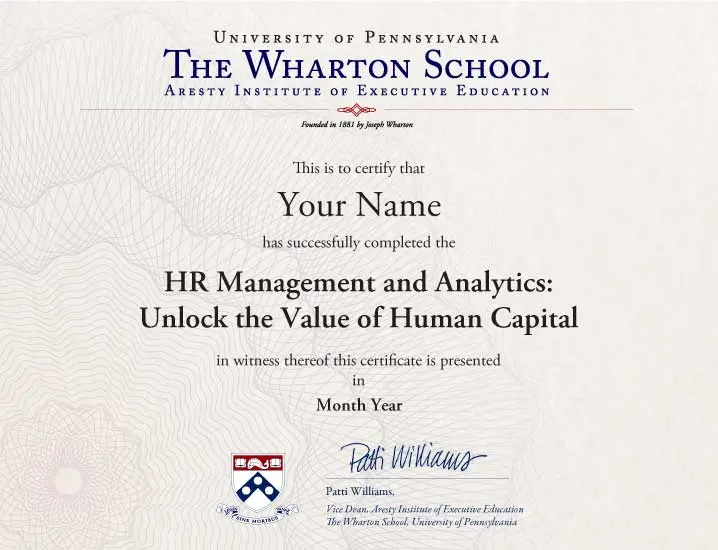HR Management and Analytics: Unlock the Value of Human Capital
Accelerate your growth as a strategic HR professional
Develop Future-Ready Skills Today
Emeritus is collaborating with Wharton Executive Education to help you build future-ready skills. Enroll before Invalid liquid data and get up to Invalid liquid data tuition assistance to set yourself up for professional success.
Who Is This Program For?
Mid to senior-level human resources and learning and development professionals
Business unit heads that crossover into human performance management
General managers
Owners of small and medium businesses with talent management oversight
Consultants and business performance professionals
Participant Titles Include:
HR Director
HR Manager
HR Generalist
HR Advisor
HR Consultant
HR Operations Head
HR Business Partner
Chief HR Officer
Group HR Manager
People Analytics Manager
People & Change Director
Program Manager People Analytics
Chief People Officer
Career Development Manager
Talent Acquisition Lead
VP Talent Management
Director of Talent Management
Director of Strategy
SVP/Operations Director
VP Human Resources
CEO
Chief of Staff
Managing Director
Consultant
General Manager
Partner
Executive Director
Operations Manager
Participant Companies Include:
DBS Bank
3M
Google
The Home Depot
Kotak Mahindra Bank
The Emirates Group
Godrej Industries Ltd
AECOM
Interops Consultings
Oasis Investments - Al Shirawi Group
Mercer Japan
Power Finance Corporation
Hear From Our Participants







Your Learning Experience
Wharton's HR Management and Analytics online program combines theory with practical application, and flexibility with rigor, to give you a holistic view of strategic HR management that includes an overview of people analytics. At the end of this program, you will be able to:
Understand the basic principles of using HR analytics to improve collaboration between employees and between departments to meet goals, whether it’s driving innovation or efficiency
Leverage data analysis to separate skill from luck; identify internal biases; and understand the staffing cycles of hiring, internal mobility, and attrition
Understand the four key factors in measuring performance: regression to the mean, sample size, signal independence, and process versus outcome
Initiate and manage people analytics projects to help you reach your organizational goals
Motivate individual performance, design reward systems, and create a desirable work environment
Create a mindset around systems of work versus individual jobs, focusing on retention and employee potential
Design an organizational structure built for recruiting top talent and competitive advantage
Program Experience

Delivered via video lectures

Delivered through a combination of video and live online lectures

Learn through individual assignments and feedback

Delivered through a combination of recorded and live video lectures
Program Topics
Program Faculty

Professor of Management, The Wharton School; Anthony L. Davis Director of the Joseph H. Lauder Institute for Management and International Studies, The University of Pennsylvania

William and Jacalyn Egan Professor of Management; Director, Center for Leadership and Change Management; Editor, Wharton Leadership Digest

George W. Taylor Professor of Management; Director, Center for Human Resources, The Wharton School

Professor of Management, The Wharton School

Practice Professor, Operations, Information and Decisions, The Wharton School

Certificate
Upon successful completion of the program, you will earn a digital certificate of completion from The Wharton School.
Note: After successful completion of the online program, your verified digital certificate will be emailed to you in the name you used when registering for the program. All certificate images are for illustrative purposes only and may be subject to change at the discretion of the Wharton School.
This online certificate program does not grant academic credit or a degree from the Wharton School of the University of Pennsylvania.
Explore other recommended programs from Wharton Executive Education
Future of Work: Leading Modern Workplaces
6 Weeks, Online
Learn to create a reliable framework to successfully navigate changes in modern workplaces.
Mastering Talent Management: Hiring, Engaging, and Rewarding A+ Talent
6 Weeks, Online
Gain the knowledge you need to hire and nurture top talent. Understand tried-and-true strategies you can use to stay ahead of the curve.
Executive Compensation: Strategies and Frameworks
6 Weeks, Online
Gain a deeper understanding of the executive compensation planning process in the context of today’s business environment and in anticipation of tomorrow’s challenges.
FAQs
Didn't find what you were looking for? Write to us at learner.success@emeritus.org or Schedule a call with one of our Academic Advisors or call us at +1 680 205 5118 (US) / +44 185 845 9995 (UK) / +65 3135 1422 (SG)
Early registrations are encouraged. Seats fill up quickly!
Flexible payment options available.
Starts On



